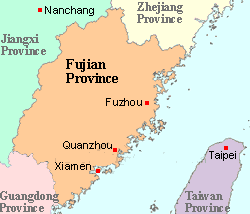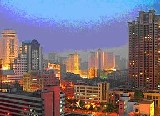Xiamen LifeXiamen is a coastal provincial
city in southeastern Fujian province.
It looks out to the Taiwan Strait and borders the cities of Quanzhou
and Zhangzhou to the north and south respectively. Xiamen is a well-known,
scenic port city commonly known as the "Garden on the Sea" and
the "Glittering Pearl on the Sea". It was one of the five
earliest special economic zones opened to the world. With its unique
local culture, beautiful scenery, heavy investment from abroad, excellent
weather all year round and booming economy, Xiamen has increasingly been
a city growing in strength, attracting the attention of the world. Xiamen has combined the long-standing traditional Minnan culture with modern western culture. Its friendly citizens and delightful environment make Xiamen one of the best cities in the world, whether for working, living or studying. The blend of eastern and western culture you encounter as you wander through the city is of endless fascination. Xiamen is the second largest city in Fujian province next to the capital city of Fuzhou, is smaller and prettier than Fuzhou. It offers a lot more to see, its streets and buildings, attractive shopping arcades and bustling seafront boasting a nineteenth-century European flavor. One of the China's most tourist friendly cities, Xiamen is
perhaps the most tastefully renovated city anywhere in the
country, giving it the feel of a holiday resort. Compounding
the resort atmosphere is the wonderful little island of Gulangyu,
a ten-minute ferry ride to the southwest. Gulangyu is the
old colonial home of Europeans and Japanese, whose mansions
still line the islands traffic free streets such that staying
on the island is highly enjoyable. Being the hometown of many overseas Chinese, Xiamen has actually benefited from the contribution of overseas Chinese and its economy has undertaken great advancement. To promote its tourism industry, it has established not only the corresponding infrastructures, but also a great variety of entertainment centers. The folk customs of the minorities, varied local festivals and especially the particular local dishes and snacks are also appealing to visitors. Xiamen, with distinct oriental culture and southern Fujian features, welcomes international friends from all over the world.
Fujian's history extends well back before the dawn of Chinese
civilization 5,000 years ago.Xiamen has a rich and dramatic
history, replete with pirates, rebel leaders, and European merchants.
Xiamen was founded in 1394 at the beginning of the Ming Dynasty
as a center of defense against coastal pirates and grew in stature
under the Ming Dynasty, becoming a thriving port by the 17th
century, influenced by a steady and rather secretive succession
of Portuguese, Spanish and Dutch fortune hunters. When invading
Manchu armies poured down from the north in the 17th century,
driving out the Ming, Xiamen became a center of resistance for
the old regime. The pirate and self-styled Prince Koxinga (also
known as Zheng Chenggong) led the resistance before being driven
out to set up his stronghold in Taiwan (incidentally, deposing
the Dutch trader who was based there) where he eventually died
before Taiwan, too, was taken by the Manchus.
Xiamen comprises Xiamen Island, Gulangyu Island, and a larger region along the mouth of Jiulong River on the continent.Huli District and most of Siming District (except Gulangyu) are on Xiamen Island, while the other four districts lie on the mainland. Xiamen Island is located very close to the island of Quemoy (Kinmen), which is governed by the Republic of China. Situated at 118.04' East and 24.26' North on the South-East coast of Fujian Province, facing Taiwan Island directly across the Taiwan Strait. Xiamen is a sightseeing heaven with its islands, rocks, temples, sea food and foreign style architecture. Also hard to resist is its mild climate, and sandy beach. Xiamen has a land area of some 1565 square kilometers, with a sea area of over 300 square kilometers under its jurisdiction. Xiamen consists of Xiamen Island, Gulangyu Island, Tong'An and the coastal areas north of the Jiulong River. Huli District and most of Ximing District (except Gulangyu) are on Xiamen Island, while the other four districts lie on the mainland. The Gaoji Causeway (Gaoqi-Jimei) built in 1955 has transformed Xiamen Island into a peninsula by linking this island with the mainland.
Xiamen and the surrounding countryside is famous for being an ancestral home
to overseas Chinese and one of China's earliest special economic zones in the
1980s. The city's economy is export oriented, with heavy dependence on foreign
trade and is empowered with both provincial level authorities in economic administration
and local legislative powers.
Xiamen is a safe place to travel, with clear blue skies and spring weather all year around. Many foreigners are happy to call Xiamen home. Economically, the special economic zone of Xiamen has been developing very fast, and remaining as one of the cities with the best environmental conditions in China. Xiamen is also regarded as the hometown of overseas Chinese, family members
of Overseas Chinese and compatriots from Hong Kong, Macao and Taiwan where
the ideal deep-sea port has no freezing season, allowing numerous people
to have resorted to this sea route to emigrate to a promised land.
|

 Located at the southeast coast of China, Xiamen is a tourist city of Fujian province
famous for its attractive seascape. As one of the major seaports since ancient
times, Xiamen boasts a wide gulf of deep water with no freezing or silting.
Due of its heavy seaport traffic, this city was named 'Xiamen' which means 'A
gate of China'. Xiamen mainly consists of Xiamen Island, Gulangyu Island, the
north bank area of the Jiulong River and Tong'an County and is connected with
the mainland by the Gaoji Seawall, Xiamen Bridge, etc. Xiamen has also been
called the Egret Island because of the hundreds of thousands of egrets inhabiting
there. This is due to the beautiful natural scenery, the fresh air and the clean
environment of the city.
Located at the southeast coast of China, Xiamen is a tourist city of Fujian province
famous for its attractive seascape. As one of the major seaports since ancient
times, Xiamen boasts a wide gulf of deep water with no freezing or silting.
Due of its heavy seaport traffic, this city was named 'Xiamen' which means 'A
gate of China'. Xiamen mainly consists of Xiamen Island, Gulangyu Island, the
north bank area of the Jiulong River and Tong'an County and is connected with
the mainland by the Gaoji Seawall, Xiamen Bridge, etc. Xiamen has also been
called the Egret Island because of the hundreds of thousands of egrets inhabiting
there. This is due to the beautiful natural scenery, the fresh air and the clean
environment of the city. After
the Opium Wars Xiamen became one of the first treaty ports to
be opened to foreign trade and settlement following the Treaty
of Nanjing in 1842. Gulangyu Island was transformed into an
international settlement, where many Victorian and Neoclassical
style buildings still survive. The city's prosperity was due
both to trade and to wealth sent back by Xiamen's substantial
emigrant community of overseas Chinese. Prosperity returned
to Xiamen in the early 1980's when Xiamen was designated one
of the four Special Economic Zones (SEZ's).
After
the Opium Wars Xiamen became one of the first treaty ports to
be opened to foreign trade and settlement following the Treaty
of Nanjing in 1842. Gulangyu Island was transformed into an
international settlement, where many Victorian and Neoclassical
style buildings still survive. The city's prosperity was due
both to trade and to wealth sent back by Xiamen's substantial
emigrant community of overseas Chinese. Prosperity returned
to Xiamen in the early 1980's when Xiamen was designated one
of the four Special Economic Zones (SEZ's).  The Xiamen Municipal Government has been encouraging industrialization since
the establishment of XMSEZ. This is to fulfill the opening-up policy and reformation
of China, as well as commitments to the World Trade Organization (WTO). The
secondary industries involving manufacturing, technology development and export
oriented industries are the most important industries in Xiamen. As one of the
mainland's first special economic zones, Xiamen has been enjoying quick economic
development since its establishment and has experienced a sustained, rapid and
coordinated growth.
The Xiamen Municipal Government has been encouraging industrialization since
the establishment of XMSEZ. This is to fulfill the opening-up policy and reformation
of China, as well as commitments to the World Trade Organization (WTO). The
secondary industries involving manufacturing, technology development and export
oriented industries are the most important industries in Xiamen. As one of the
mainland's first special economic zones, Xiamen has been enjoying quick economic
development since its establishment and has experienced a sustained, rapid and
coordinated growth.